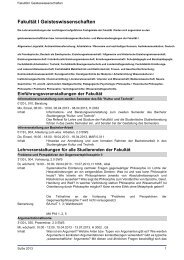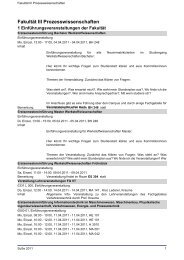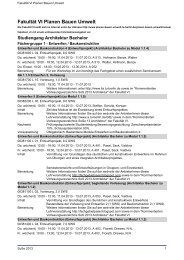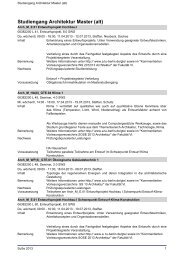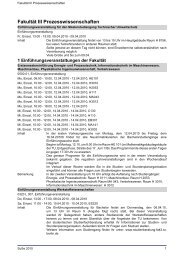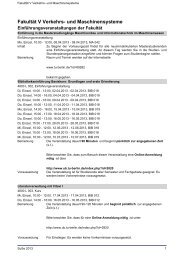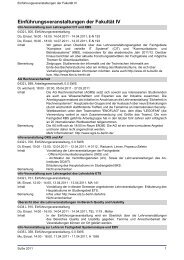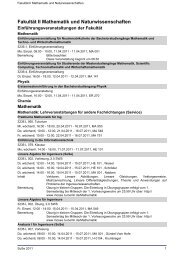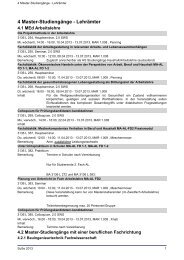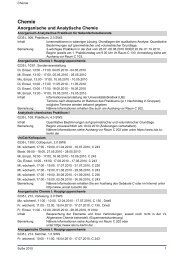Diplomstudiengänge der Fakultät IV (Elektrotechnik ... - TU Berlin
Diplomstudiengänge der Fakultät IV (Elektrotechnik ... - TU Berlin
Diplomstudiengänge der Fakultät IV (Elektrotechnik ... - TU Berlin
Erfolgreiche ePaper selbst erstellen
Machen Sie aus Ihren PDF Publikationen ein blätterbares Flipbook mit unserer einzigartigen Google optimierten e-Paper Software.
<strong>Diplomstudiengänge</strong> <strong>der</strong> <strong>Fakultät</strong> <strong>IV</strong><br />
(<strong>Elektrotechnik</strong>, Informatik, Technische Informatik)<br />
* Optimale Mehrnutzerdetektion<br />
* Lineare Mehrnutzerdetektion<br />
* Entscheidungsgesteuerte Mehrnutzerdetektion<br />
* Leistungskontrolle (power control)<br />
* Analyse interferenzgekoppelter Systeme<br />
* Optimale Vergabe von Ressourcen, SINR Region<br />
* Iterative Algorithmen zur Ressourcenverteilung<br />
Bemerkung * Die Vorlesung wendet sich an Studierende im Hauptstudium <strong>der</strong> Fachrichtung<br />
<strong>Elektrotechnik</strong> mit Schwerpunkt Nachrichtentechnik.<br />
* Vertiefung zu den Vorlesungen Digitale Mobilkommunikation I und Digitale<br />
Mobilkommunikation II<br />
Voraussetzung * Gute Kenntnisse <strong>der</strong> Nachrichten- und Mobilfunktechnik<br />
* Grundlegende Kenntnisse <strong>der</strong> Wahrscheinlichkeitstheorie<br />
* Grundlegende Kenntnisse <strong>der</strong> linearen Algebra<br />
Analytical Methods for Security and Risk Management<br />
0434 L 980, Seminar, 2.0 SWS<br />
Block, 01.08.2011 - 05.08.2011<br />
Inhalt Security of networked computing systems is a topic of increasing importance both in<br />
practice and in research, as the mo<strong>der</strong>n society depends on autonomous networked<br />
systems in all aspects of life. Security is a multi-faceted and complex problem that poses<br />
significant challenges, and hence, requires a broad perspective and innovative solutions<br />
that go beyond empirical research. Analytical methods and mathematical models are an<br />
important part of security domain as the field matures from its earlier qualitative nature.<br />
Such methods help individuals and organizations manage emerging security problems<br />
and related risks in an principled way as well as facilitate development of security services<br />
and computer support systems.<br />
Topics investigated in analytical methods for security and risk management include<br />
- anomaly and malware detection in networked systems<br />
- resource allocation in security<br />
- optimized response to security epidemics and problems<br />
- security risk management<br />
- usability, privacy, digital identity, and evolution of reputation.<br />
References (Literatur):<br />
1) T. Alpcan and T. Ba#ar. Network Security: A Decision and Game Theoretic Approach.<br />
Cambridge University Press, 2011.<br />
2) L. Buttyan and J.-P. Hubaux, Security and Cooperation in Wireless Networks.<br />
Cambridge University Press, 2008.<br />
3) P. R. Garvey, Analytical Methods for Risk Management: A Systems Engineering<br />
Perspective, ser. Statistics: a Series of Textbooks and Monographs. Boca Raton, FL,<br />
USA: Chapman and Hall/CRC, 2009.<br />
Bemerkung Bitte kontaktieren Sie Fr. Christine Kluge (Christine.Kluge@telekom.de) für Anmeldung<br />
und bei Fragen zum Seminar. Der Seminar Termin ist flexibel und kann bei Bedarf<br />
angepasst werden.<br />
Statistische Nachrichtentheorie<br />
0432 L 212, Vorlesung, 2.0 SWS<br />
Informationen über aSec auf http://www.asec.tu-berlin.de/<br />
über Prof. Tansu Alpcan auf http://www.tansu.alpcan.org/<br />
Do, wöchentl, 12:00 - 14:00, 14.04.2011 - 14.07.2011, HFT-FT 131 , Sikora<br />
Inhalt "Statistical communication Theory" - Statistische Nachrichtenbeschreibungen,<br />
stochastische Prozesse, lineare Transformationen, ein- und zweidimensionale<br />
Nachrichtenquellen, Wiener-Kolmogoroff-Filterung, lineare Prädiktion, Verfahren <strong>der</strong><br />
Störbefreiung bei Sprach-, Audio- und Bildsignalen.<br />
SoSe 2011 32



